torque ISUZU AXIOM 2002 Service Repair Manual
[x] Cancel search | Manufacturer: ISUZU, Model Year: 2002, Model line: AXIOM, Model: ISUZU AXIOM 2002Pages: 2100, PDF Size: 19.35 MB
Page 694 of 2100

5C±14
POWER±ASSISTED BRAKE SYSTEM
Brake Pipe
Removal
1. Raise the vehicle and support it with suitable safety
stands.
2. Remove wheel and tire assembly as necessary.
3. Clean dirt, grease, and other foreign material off the
pipe fittings at both ends.
4. Remove brake pipe (1).
330RW011
5. Remove plastic clip (2).
330RW002
Installation
To install, follow the removal steps in the reverse order,
noting the following points.
1. Tighten the brake pipes to the specified torque.
Master cylinder and Proportioning and Bypass
valve sides
Torque: 15 N´m (11 lb ft)
Others
Torque: 16 N´m (12 lb ft)
After installing the brake pipes, bleed the brakes as
described in this section.
Page 695 of 2100

5C±15 POWER±ASSISTED BRAKE SYSTEM
P & B (Proportioning and Bypass) Valve
P & B (Proportioning and Bypass)
Valve Sectional View
350RW014
Legend
(1) Master Cylinder (Secondary)
(2) Master Cylinder (Primary)
(3) Rear Brake
(4) Front Brake
The P&B valve contains two sections, each serving a
different function.
The proportioning section of the P&B valve proportions
outlet pressure to the rear brakes after a predetermined
rear input pressure has been reached. This is done to
prevent rear wheel lock up on the vehicles with light rear
wheel loads. The valve has a by±pass feature which
assures full system pressure to the rear brakes in the
event of front brake system malfunction. Also full front
pressure is retained in the event of rear brake
malfunction.
The P&B valve is not repairable and must be replaced as
complete assembly.
Removal
1. The P&B valve is not repairable and must be replaced
as a complete assembly. Care must be taken to
prevent brake fluid from contacting any painted
surface.
2. Remove hydraulic pipes (1) and plug the pipes (1) to
prevent the loss of fluid or the entrance of dirt.
3. Remove bolt (3).
4. Remove P&B valve (2).
350RW026
Installation
1. Install P&B valve (2).
2. Install bolt (3) and tighten the bolt to the specified
torque.
Torque: 22 N´m (16 lb ft)
3. Install hydraulic pipes (1) and tighten the bolt to the
specified torque.
Torque: 15 N´m (11 lb ft)
4. After installing the brake pipes, bleed the brakes as
refer to
Bleeding Brake Hydraulic System in this
section.
Page 696 of 2100

5C±16
POWER±ASSISTED BRAKE SYSTEM
Main Data and Specifications
Torque Specifications
E05R200001
Page 697 of 2100
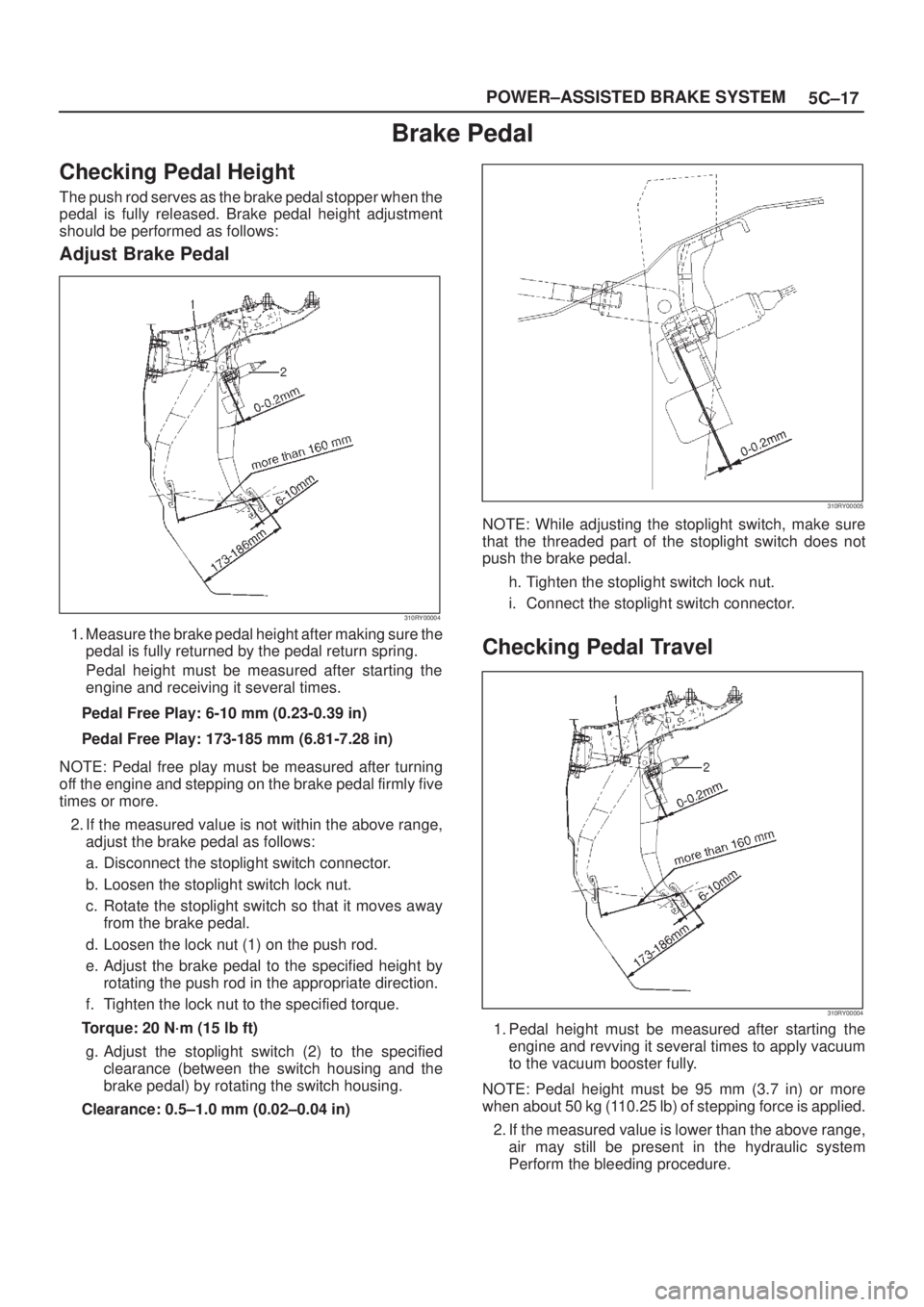
5C±17 POWER±ASSISTED BRAKE SYSTEM
Brake Pedal
Checking Pedal Height
The push rod serves as the brake pedal stopper when the
pedal is fully released. Brake pedal height adjustment
should be performed as follows:
Adjust Brake Pedal
310RY00004
1. Measure the brake pedal height after making sure the
pedal is fully returned by the pedal return spring.
Pedal height must be measured after starting the
engine and receiving it several times.
Pedal Free Play: 6-10 mm (0.23-0.39 in)
Pedal Free Play: 173-185 mm (6.81-7.28 in)
NOTE: Pedal free play must be measured after turning
off the engine and stepping on the brake pedal firmly five
times or more.
2. If the measured value is not within the above range,
adjust the brake pedal as follows:
a. Disconnect the stoplight switch connector.
b. Loosen the stoplight switch lock nut.
c. Rotate the stoplight switch so that it moves away
from the brake pedal.
d. Loosen the lock nut (1) on the push rod.
e. Adjust the brake pedal to the specified height by
rotating the push rod in the appropriate direction.
f. Tighten the lock nut to the specified torque.
Torque: 20 N´m (15 lb ft)
g. Adjust the stoplight switch (2) to the specified
clearance (between the switch housing and the
brake pedal) by rotating the switch housing.
Clearance: 0.5±1.0 mm (0.02±0.04 in)
310RY00005
NOTE: While adjusting the stoplight switch, make sure
that the threaded part of the stoplight switch does not
push the brake pedal.
h. Tighten the stoplight switch lock nut.
i. Connect the stoplight switch connector.
Checking Pedal Travel
310RY00004
1. Pedal height must be measured after starting the
engine and revving it several times to apply vacuum
to the vacuum booster fully.
NOTE: Pedal height must be 95 mm (3.7 in) or more
when about 50 kg (110.25 lb) of stepping force is applied.
2. If the measured value is lower than the above range,
air may still be present in the hydraulic system
Perform the bleeding procedure.
Page 698 of 2100
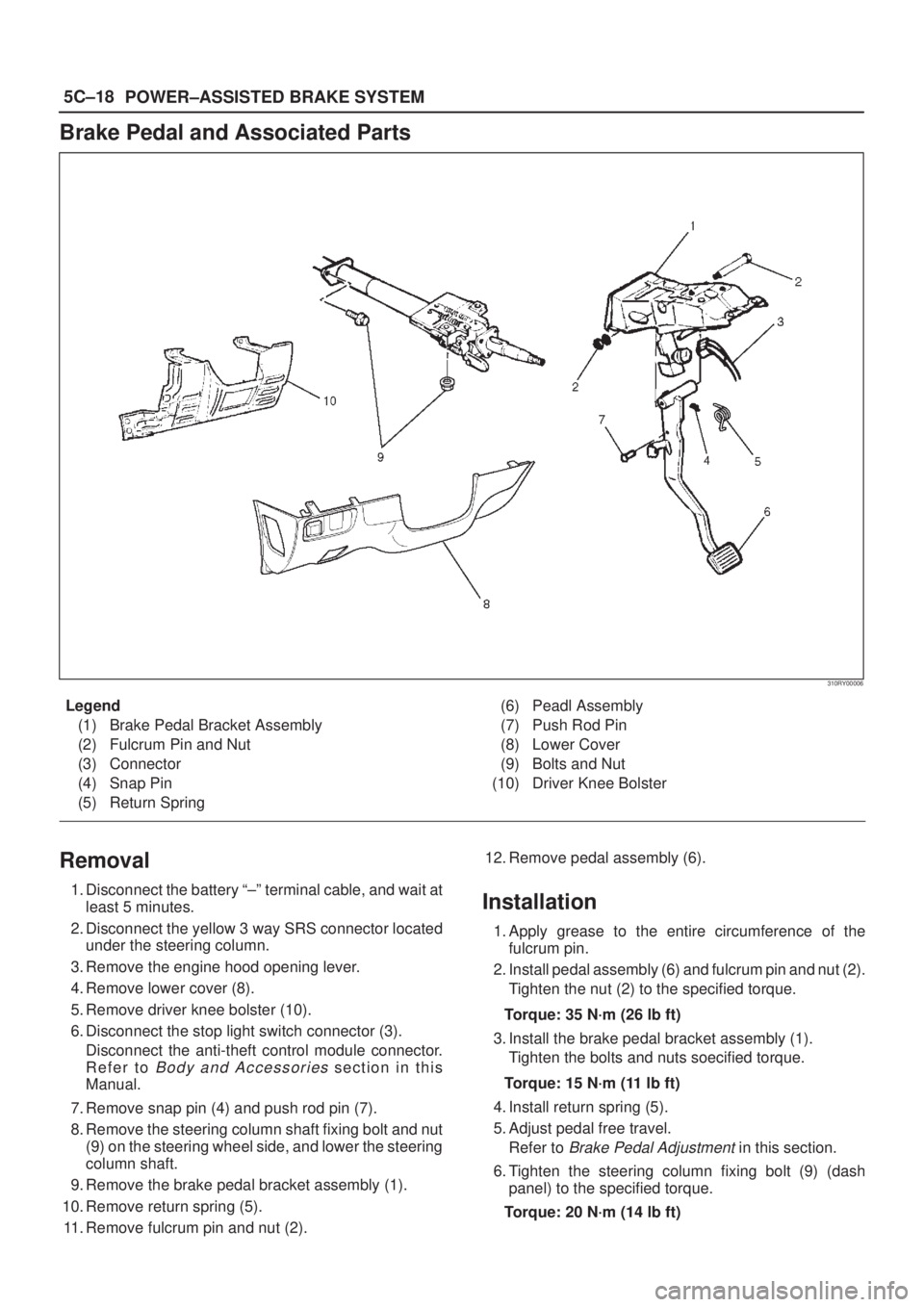
5C±18
POWER±ASSISTED BRAKE SYSTEM
Brake Pedal and Associated Parts
310RY00006
Legend
(1) Brake Pedal Bracket Assembly
(2) Fulcrum Pin and Nut
(3) Connector
(4) Snap Pin
(5) Return Spring(6) Peadl Assembly
(7) Push Rod Pin
(8) Lower Cover
(9) Bolts and Nut
(10) Driver Knee Bolster
Removal
1. Disconnect the battery ª±º terminal cable, and wait at
least 5 minutes.
2. Disconnect the yellow 3 way SRS connector located
under the steering column.
3. Remove the engine hood opening lever.
4. Remove lower cover (8).
5. Remove driver knee bolster (10).
6. Disconnect the stop light switch connector (3).
Disconnect the anti-theft control module connector.
Refer to
Body and Accessories section in this
Manual.
7. Remove snap pin (4) and push rod pin (7).
8. Remove the steering column shaft fixing bolt and nut
(9) on the steering wheel side, and lower the steering
column shaft.
9. Remove the brake pedal bracket assembly (1).
10. Remove return spring (5).
11. Remove fulcrum pin and nut (2).12. Remove pedal assembly (6).
Installation
1. Apply grease to the entire circumference of the
fulcrum pin.
2. Install pedal assembly (6) and fulcrum pin and nut (2).
Tighten the nut (2) to the specified torque.
Torque: 35 N´m (26 lb ft)
3. Install the brake pedal bracket assembly (1).
Tighten the bolts and nuts soecified torque.
Torque: 15 N´m (11 lb ft)
4. Install return spring (5).
5. Adjust pedal free travel.
Refer to
Brake Pedal Adjustment in this section.
6. Tighten the steering column fixing bolt (9) (dash
panel) to the specified torque.
Torque: 20 N´m (14 lb ft)
Page 699 of 2100
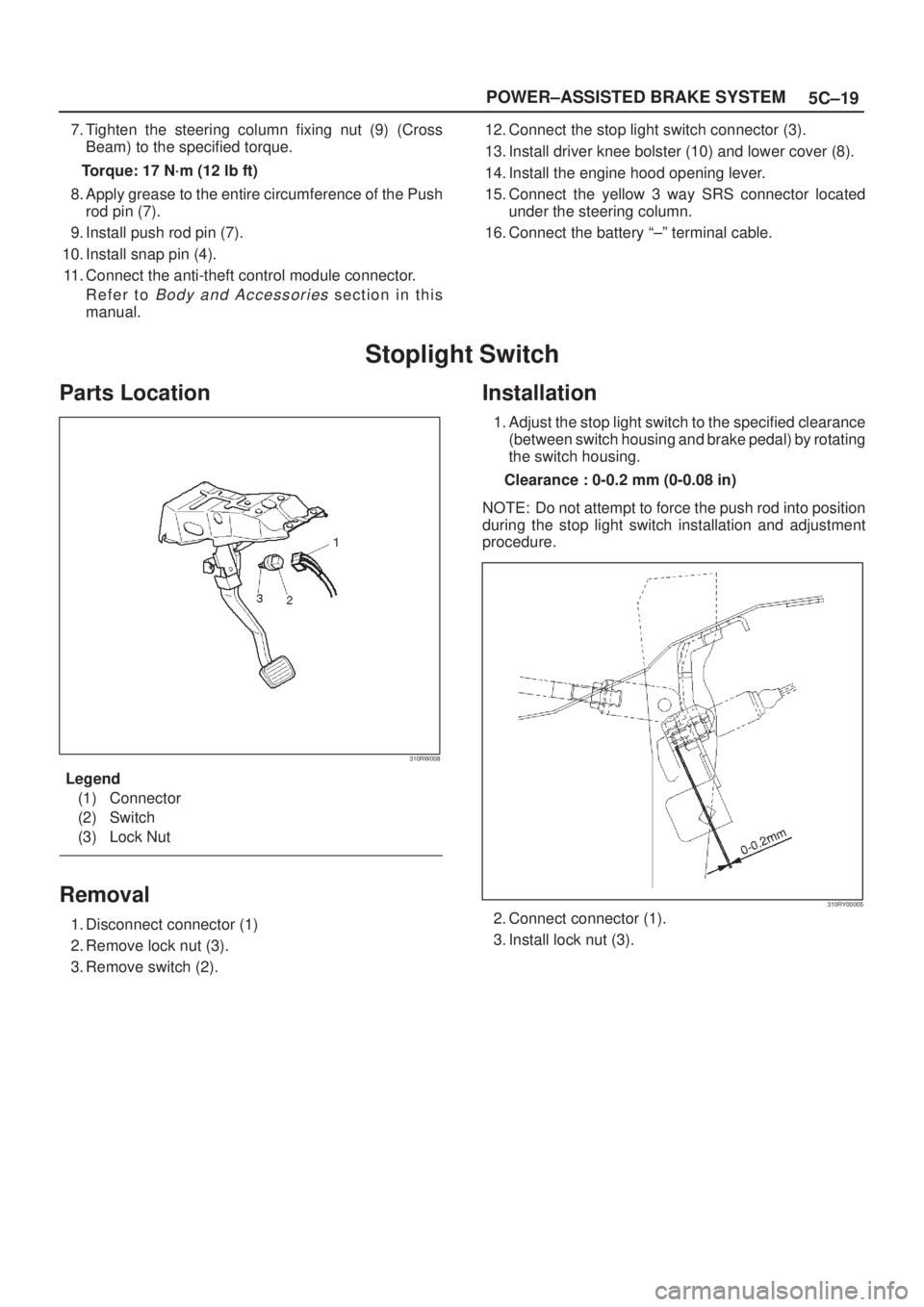
5C±19 POWER±ASSISTED BRAKE SYSTEM
7. Tighten the steering column fixing nut (9) (Cross
Beam) to the specified torque.
Torque: 17 N´m (12 lb ft)
8. Apply grease to the entire circumference of the Push
rod pin (7).
9. Install push rod pin (7).
10. Install snap pin (4).
11. Connect the anti-theft control module connector.
Refer to
Body and Accessories section in this
manual.12. Connect the stop light switch connector (3).
13. Install driver knee bolster (10) and lower cover (8).
14. Install the engine hood opening lever.
15. Connect the yellow 3 way SRS connector located
under the steering column.
16. Connect the battery ª±º terminal cable.
Stoplight Switch
Parts Location
310RW008
Legend
(1) Connector
(2) Switch
(3) Lock Nut
Removal
1. Disconnect connector (1)
2. Remove lock nut (3).
3. Remove switch (2).
Installation
1. Adjust the stop light switch to the specified clearance
(between switch housing and brake pedal) by rotating
the switch housing.
Clearance : 0-0.2 mm (0-0.08 in)
NOTE: Do not attempt to force the push rod into position
during the stop light switch installation and adjustment
procedure.
310RY00005
2. Connect connector (1).
3. Install lock nut (3).
Page 700 of 2100

5C±20
POWER±ASSISTED BRAKE SYSTEM
Main Data and Specifications
General Specifications
Pedal free play6±10 mm (0.23 ±0.39 in)
Pedal Height173±185 mm (6.81±7.28 in)
Torque Specifications
310RY00007
Page 703 of 2100
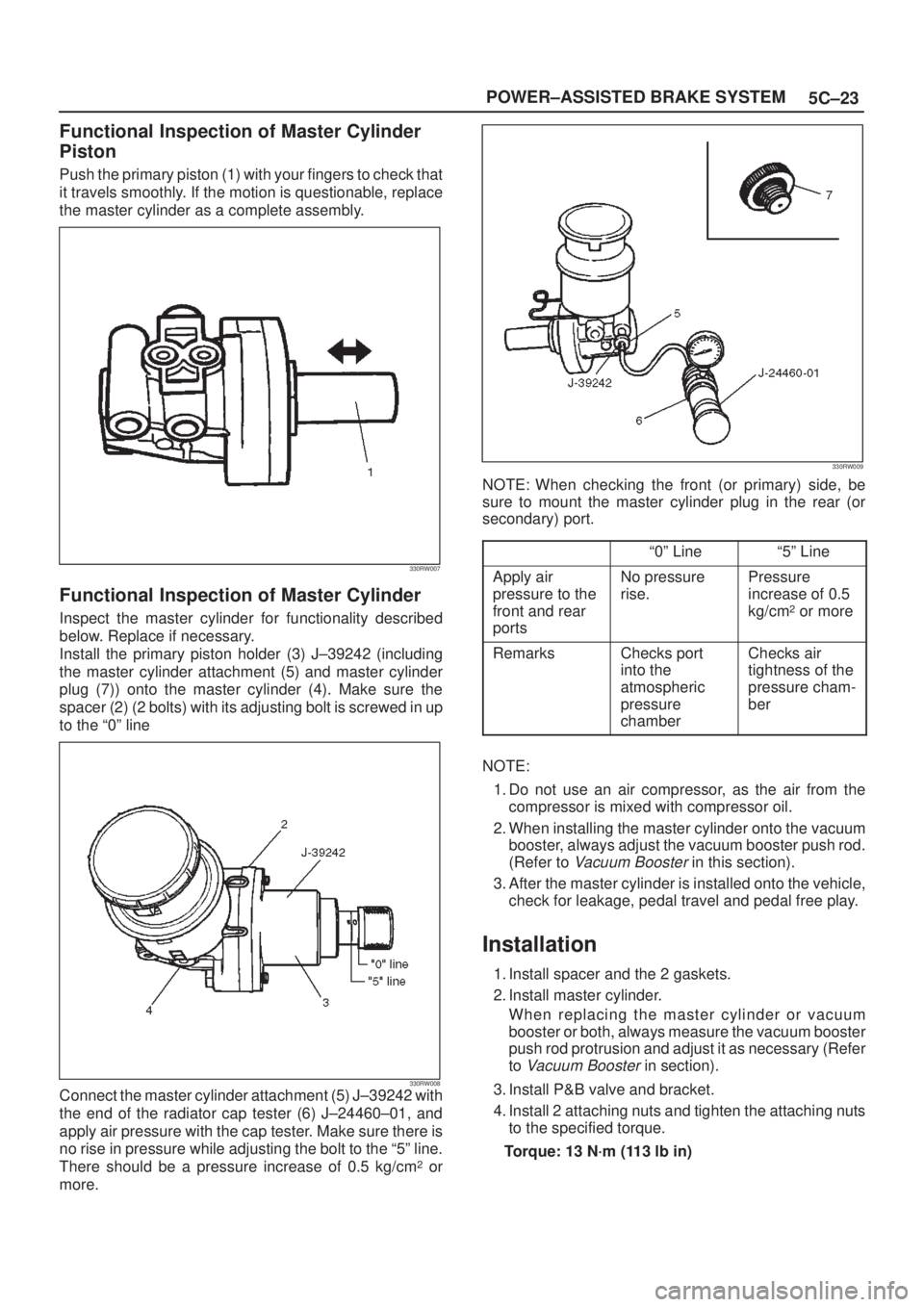
5C±23 POWER±ASSISTED BRAKE SYSTEM
Functional Inspection of Master Cylinder
Piston
Push the primary piston (1) with your fingers to check that
it travels smoothly. If the motion is questionable, replace
the master cylinder as a complete assembly.
330RW007
Functional Inspection of Master Cylinder
Inspect the master cylinder for functionality described
below. Replace if necessary.
Install the primary piston holder (3) J±39242 (including
the master cylinder attachment (5) and master cylinder
plug (7)) onto the master cylinder (4). Make sure the
spacer (2) (2 bolts) with its adjusting bolt is screwed in up
to the ª0º line
330RW008Connect the master cylinder attachment (5) J±39242 with
the end of the radiator cap tester (6) J±24460±01, and
apply air pressure with the cap tester. Make sure there is
no rise in pressure while adjusting the bolt to the ª5º line.
There should be a pressure increase of 0.5 kg/cm
2 or
more.
330RW009
NOTE: When checking the front (or primary) side, be
sure to mount the master cylinder plug in the rear (or
secondary) port.
ª0º Lineª5º Line
Apply air
pressure to the
front and rear
portsNo pressure
rise.Pressure
increase of 0.5
kg/cm
2 or more
RemarksChecks port
into the
atmospheric
pressure
chamberChecks air
tightness of the
pressure cham-
ber
NOTE:
1. Do not use an air compressor, as the air from the
compressor is mixed with compressor oil.
2. When installing the master cylinder onto the vacuum
booster, always adjust the vacuum booster push rod.
(Refer to
Vacuum Booster in this section).
3. After the master cylinder is installed onto the vehicle,
check for leakage, pedal travel and pedal free play.
Installation
1. Install spacer and the 2 gaskets.
2. Install master cylinder.
When replacing the master cylinder or vacuum
booster or both, always measure the vacuum booster
push rod protrusion and adjust it as necessary (Refer
to
Vacuum Booster in section).
3. Install P&B valve and bracket.
4. Install 2 attaching nuts and tighten the attaching nuts
to the specified torque.
Torque: 13 N´m (113 lb in)
Page 704 of 2100
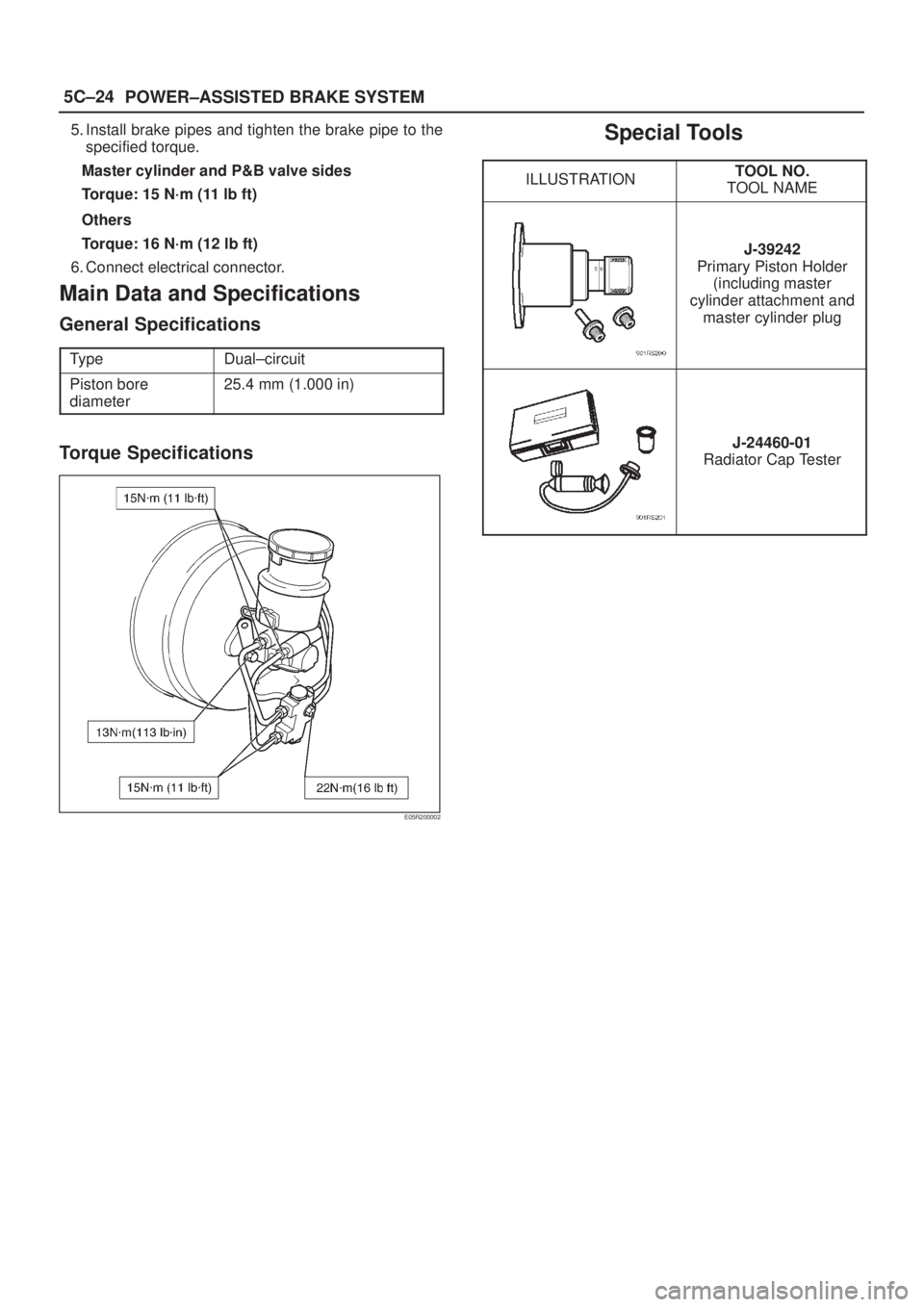
5C±24
POWER±ASSISTED BRAKE SYSTEM
5. Install brake pipes and tighten the brake pipe to the
specified torque.
Master cylinder and P&B valve sides
Torque: 15 N´m (11 lb ft)
Others
Torque: 16 N´m (12 lb ft)
6. Connect electrical connector.
Main Data and Specifications
General Specifications
TypeDual±circuit
Piston bore
diameter25.4 mm (1.000 in)
Torque Specifications
E05R200002
Special Tools
ILLUSTRATIONTOOL NO.
TOOL NAME
J-39242
Primary Piston Holder
(including master
cylinder attachment and
master cylinder plug
J-24460-01
Radiator Cap Tester
Page 707 of 2100

5C±27 POWER±ASSISTED BRAKE SYSTEM
4. Measure dimension (4).
Dimension (4) (Standard): ±0.1±0.1 mm
(±0.0039±0.0039 in)
331RW002
5. If dimension (4) is out of the standard range, adjust
push rod using the Push Rod Support J±39241.
331RW003
6. Mount plate and seal assembly in vacuum booster
front shell. Then install the retainer.
7. Install vacuum booster fixing nut and tighten the
specified torque.
Torque: 15 N´m (11 lb ft)
8. Install yoke clevis.
9. Connect vacuum hose and make sure that the arrow
on the hose points in the direction of the engine.
10. Install master cylinder, refer to
Master Cylinder
Installation
in this section.